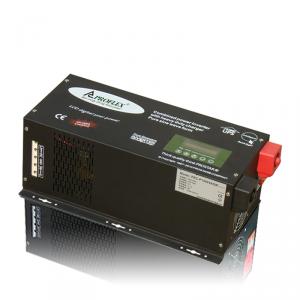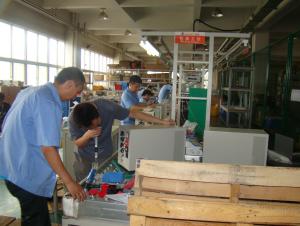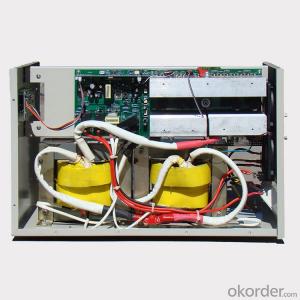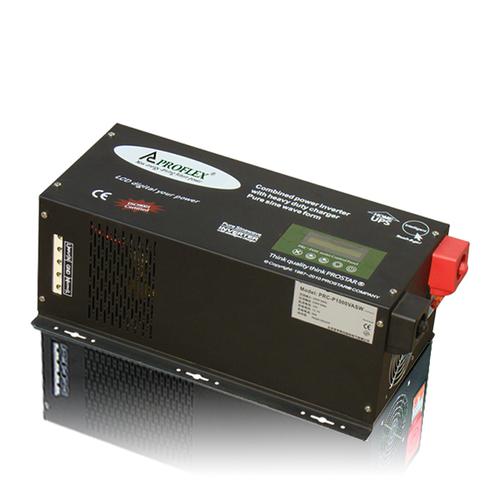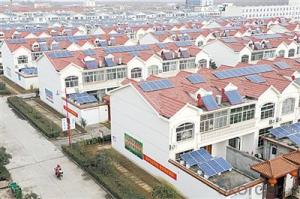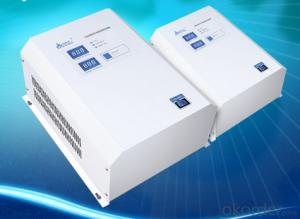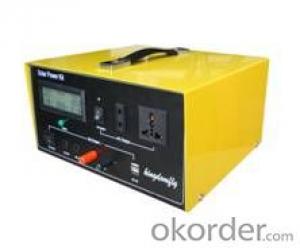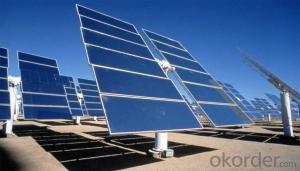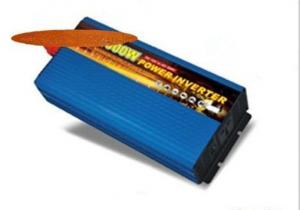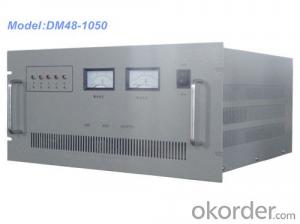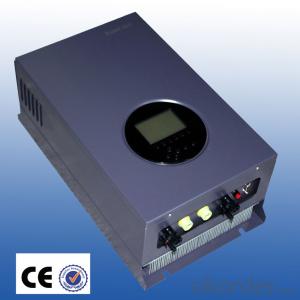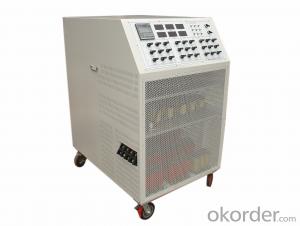Baywa Re Solar Energy Systems - Pure Sine Wave Power Inverter with Battery Charger 5KW
- Loading Port:
- Tianjin
- Payment Terms:
- TT OR LC
- Min Order Qty:
- 10 pc
- Supply Capability:
- 10000 pc/month
OKorder Service Pledge
OKorder Financial Service
You Might Also Like
Specification
Specifications
DC to AC power inverter
Pure sine wave
with battery charger
standard LCD display
Battery charge current can be manually set
DC TO AC INVERTER
PURE SINE WAVE WITH BATTERY CHARGER
Advantages
> Ultra-fast transfer timeFrom AC to DC less than 5ms,
> From DC to AC 0ms (Routers, Switches PC, Servers and ATM machine will never re-start at Mains failure)
> Faster battery recharge time (Big charge current 30A~50A)
> Automatic tracking mains or generator input (Tracking input voltage, phase & frequency)
> AC / DC conversion waveform (Seamless connection without any spike)
> Battery equalization system (for longer battery life)
> Protection against short-circuit, low voltage, overload, over temperature and over-charge
> Low maintenance cost, LED & LCD Dual display
Application range
Computer, Telecom, Deep Freezers, Air Conditioners, Petrol pump machines, Small Scale Industries Malls, Hotels,
Restaurants, Banks, ATM Machines, Clinics, All kinds of Kitchen appliances & Home appliances, Weighing bridges,
Elevators etc.
Technical Specification
| PRC-PSW SERIES | 500VA | 1000VA | 1500VA | 2000VA | 3000VA | 4000VA | 5000VA | 6250VA |
| POWER CAPACITY | 400W | 800W | 1200W | 1600W | 2400W | 3200W | 4000W | 5000W |
| BATTERY DC VOLTAGE | 12V/24V/48V | 24V/48V | ||||||
| INPUT AC RANGE | 140~280V / 45~55Hz | 165~275V / 45~55Hz | ||||||
| INVERTER OUTPUT | 220V ± 10% / 50Hz ± 1% | Without AVR function | ||||||
| TRANSFER (AC LOSS) | 5ms after AC loss, automatic recovery after utility power back | |||||||
| WAVE DISTORTION | THD < 3% | |||||||
| OVER LOAD CAPACITY | 100% ~ 125% Keep Beeping; > 125% working 30s; >150% 1s shut down | |||||||
| OUTPUT SOCKET | terminal connectors | |||||||
| INDICATOR STATUS | Utility input with "POWER" & "BYPASS" light on | |||||||
| Utility power loss with "INVERTER" light on | ||||||||
| Connected with load "AC OUTPUT" light on | ||||||||
| Warning for battery low & over load with " ! " flashing | ||||||||
| Battery low protection, over load protection, short circuit protection with " ! " light on | ||||||||
| BATTERY CAPACITY | From left to right 4 indicator means 100%, 75%, 50%, 25% (" ! "Flashing) | |||||||
| CHARGE STATUS | Indicator flash change from 50% →75% → 100% every 1second means "CONSTANT CURRENT" | |||||||
| Indicator flash change from 50% →75% → 100% every 2second means "CONSTANT VOLTAGE" | ||||||||
| Indicator 50%/75%/100% 3lights on means "FLOAT CHARGE" & battery full | ||||||||
| CHARGE CURRENT | Maximum 12V 30A / 24V 20A / 48V 10A | Maximum 24V 50A or 48V 30A | ||||||
| 10A → 20A → 30A Adjustable | 10A → 30A → 50A Adjustable | |||||||
| RECHARGE TIME | 8~10hours | |||||||
| POWER EFFICIENCY | 88% at full load | 85% at full load | ||||||
| NOISE CONDITION | < 45dB | |||||||
| TEMPERATURE | —10°C ~ 40°C (Operation environment); —20°C ~ 50°C (Stock environment) | |||||||
| HUMIDITY | 0~95% no condensation | |||||||
| SIZE OF INVERTER | 550 x 250 x 200mm | 650 x 250 x 200 mm | 68x31x28cm | |||||
| SIZE OF PACKAGE | 58x28x23cm / 1unit | 68x28x23cm / 1unit | 71x34x31cm | |||||
| TYPE OF PACKAGE | Honeycomb carton | |||||||
| WEIGHT OF INVERTER | 11kg | 13kg | 14kg | 25kg | 27kg | 38kg | 39kg | 47kg |
| WEIGHT AFTER PACKAGING | 13kg | 15kg | 16kg | 27kg | 29kg | 40kg | 41kg | 49kg |
Advantages
CPU control, Low frequency
Pure sine wave output
5ms transfer time for AC to DC
Input voltage range 80V~140V/160V~265V
Input frequency range 45~55Hz/55~65Hz
Easy to install, easy to use
Intelligent automatic charging
Compatible with generators
Using line interactive circuit technology
Automatically AC bypass
Software & SNMP card optional with adding cost
Electronic Protections
Overload, short circuit protection
Over temperature protection
Over voltage, low voltage protection
Low battery protection


- Q: How do solar energy systems impact energy education and awareness?
- Solar energy systems have a significant impact on energy education and awareness by providing tangible examples of clean, renewable energy sources. They serve as effective educational tools, allowing individuals to learn about the benefits and potential of solar power. By witnessing the practical application of solar energy, people become more aware of its importance in reducing carbon emissions and mitigating climate change. This increased awareness helps drive further interest in energy conservation, sustainability, and the adoption of renewable energy technologies.
- Q: Can solar energy systems be installed on the ground?
- Yes, solar energy systems can be installed on the ground. In fact, ground-mounted solar systems are a popular choice for both residential and commercial applications. These systems typically consist of solar panels mounted on a structure or framework that is anchored to the ground. Ground-mounted systems offer several advantages over rooftop installations, such as increased flexibility in system design, easier access for maintenance and cleaning, and the ability to optimize the orientation and tilt angle of the panels for maximum energy production. Additionally, ground-mounted systems can be installed in areas with limited roof space or where the roof is not suitable for solar panel installation. Overall, ground-mounted solar energy systems provide a practical and efficient way to harness the power of the sun for electricity generation.
- Q: Can solar energy systems be used in powering disaster relief centers or emergency shelters?
- Solar energy systems can indeed be used to power disaster relief centers or emergency shelters. In fact, these systems are increasingly being utilized in such situations due to their numerous benefits. One of the main advantages of solar energy systems is their ability to operate independently from the grid. When natural disasters or emergencies occur, the conventional power grid may be disrupted or completely unavailable. In such cases, solar panels can generate electricity from sunlight, providing a reliable and sustainable source of power for essential operations in relief centers or shelters. Furthermore, solar energy systems are highly portable and modular, making them ideal for temporary installations. They can be quickly deployed and set up in disaster-stricken areas, offering immediate power for lighting, communication devices, medical equipment, and other critical needs. Additionally, these systems can be easily expanded or adjusted to meet the increasing energy demands of relief centers or shelters as the situation unfolds. Moreover, solar power systems have minimal environmental impact compared to traditional fuel-based generators. They produce clean energy without emitting harmful pollutants or greenhouse gases, which is particularly important in disaster-stricken areas where air quality may already be compromised. Lastly, solar energy systems provide long-term cost savings. Once installed, solar panels require minimal maintenance and have a lifespan of 25-30 years. This reduces the reliance on expensive and often scarce fuel supplies, enabling relief centers and emergency shelters to allocate their resources more efficiently. To conclude, solar energy systems are a reliable, sustainable, and cost-effective solution for powering disaster relief centers or emergency shelters. Their ability to operate independently, portability, minimal environmental impact, and long-term cost savings make them an excellent choice for powering critical operations during times of crisis.
- Q: Can solar energy systems be used in powering manufacturing plants?
- Yes, solar energy systems can be used to power manufacturing plants. By installing solar panels and utilizing solar energy, manufacturing plants can reduce their reliance on traditional fossil fuel-based electricity and significantly lower their carbon footprint. Solar energy systems can provide a sustainable and renewable source of power for various manufacturing processes, helping to promote cleaner and more environmentally friendly production methods.
- Q: Can solar energy systems be used in powering electric fences or security systems?
- Certainly, electric fences or security systems can be powered by solar energy systems. The conversion of sunlight into energy by solar panels enables the generation of electricity, which can be stored in batteries or used directly to operate different devices. This renders solar energy systems a feasible and sustainable alternative for powering electric fences or security systems, particularly in remote or off-grid areas where conventional power sources may not be accessible or dependable. Solar-powered electric fences effectively discourage intruders or confine animals within a specific area, while solar-powered security systems provide continuous surveillance and monitoring without the requirement of a constant electricity supply. Moreover, solar energy systems are eco-friendly and aid in reducing carbon emissions related to traditional power sources, thus becoming an increasingly sought-after and cost-efficient solution for diverse applications, including electric fences and security systems.
- Q: Can solar energy systems be used in areas with high levels of light pollution?
- Yes, solar energy systems can still be used in areas with high levels of light pollution. While light pollution can reduce the efficiency of solar panels by obstructing direct sunlight, solar energy systems can still generate electricity even in less ideal conditions. It is important to note that the overall performance of the system may be affected, but advancements in solar technology and proper positioning of panels can help mitigate the impact of light pollution on solar energy generation.
- Q: Can solar energy systems be used for powering satellites?
- Yes, solar energy systems can be used for powering satellites. Solar panels on satellites capture sunlight and convert it into electricity, which is stored in batteries for use during periods of darkness or when sunlight is obstructed. This sustainable energy source is reliable and widely used in the space industry to power satellites and other space missions.
- Q: How does the size of solar panels impact energy production?
- Energy production is directly affected by the size of solar panels, as it dictates the quantity of sunlight that can be captured and transformed into electricity. Solar panels of larger dimensions possess a greater surface area, enabling them to absorb a larger amount of sunlight and generate a higher electricity output. Consequently, larger panels have the capability to produce more energy in comparison to smaller ones. Moreover, larger panels can accommodate a greater number of solar cells, thereby further augmenting their energy production capacity. Nevertheless, it is crucial to consider the available space, cost, and specific energy requirements when determining the appropriate size of solar panels.
- Q: Can solar energy systems be used for powering off-grid eco-commercial complexes?
- Yes, solar energy systems can definitely be used for powering off-grid eco-commercial complexes. Solar panels can be installed on the rooftops or open spaces of these complexes to generate clean and renewable energy. This energy can then be stored in batteries for use during non-sunlight hours. By utilizing solar power, off-grid eco-commercial complexes can reduce their reliance on fossil fuels, decrease their carbon footprint, and promote sustainable practices.
- Q: Can solar energy systems be installed in areas with high snowfall?
- Yes, solar energy systems can be installed in areas with high snowfall. However, it is important to consider the design and installation of the system to ensure optimal performance and prevent damage from heavy snow loads. Strategies such as mounting the panels at an angle, using snow guards, and regular snow removal can help maximize energy production in snowy conditions.
Send your message to us
Baywa Re Solar Energy Systems - Pure Sine Wave Power Inverter with Battery Charger 5KW
- Loading Port:
- Tianjin
- Payment Terms:
- TT OR LC
- Min Order Qty:
- 10 pc
- Supply Capability:
- 10000 pc/month
OKorder Service Pledge
OKorder Financial Service
Similar products
Hot products
Hot Searches
Related keywords
